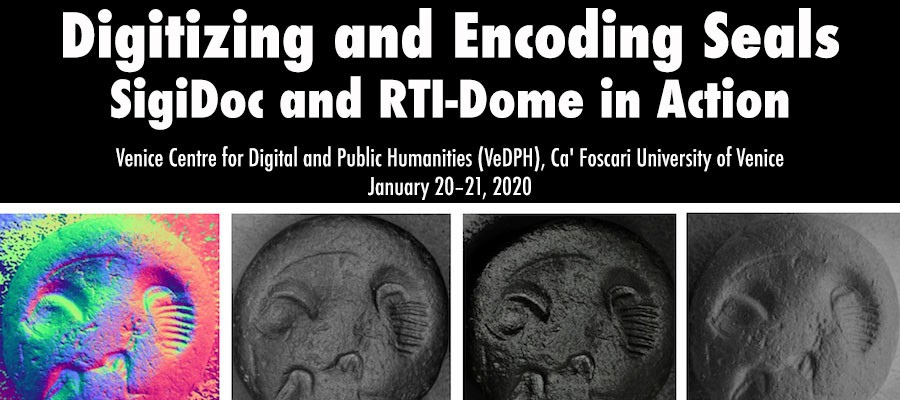Digitizing and Encoding Seals: SigiDoc and RTI-Dome in Action, Venice Centre for Digital and Public Humanities (VeDPH), Ca' Foscari University of Venice, January 20–21, 2020
We invite applications for a two-day workshop in digitizing and encoding ancient seals, hosted by the Venice Centre for Digital and Public Humanities (VeDPH) at the Department for the Humanities, Ca’ Foscari University of Venice, January 20-21, 2020.
The aim of the workshop is to present and discuss solutions, currently under development, concerning an XML-based and TEI-compliant data model for the description of Byzantine seals – and, with minor adjustments, of other coin-like objects, such as bread stamps, Hellenistic or Western Medieval seals and sealings. For this purpose, participants will be introduced to a new encoding standard: SigiDoc, the first attempt to adapt and extend the digital approach – already applied to inscriptions, coins and papyri – to seals. SigiDoc builds on the experience of the EpiDoc encoding standard and its customisable publication platform EFES (EpiDoc Front End Services). The introduction into the methodology and functionalities of both SigiDoc and EFES will take place during the first half of the workshop, followed by hands-on training sessions on the second day. The final session of the workshop will be dedicated to discussing challenges and solutions to open issues within the development of SigiDoc, as well as the questions and suggestions arising from the participants.
The workshop will also feature an introduction and a practical demonstration of Reflective Transformation Imaging (RTI), a cutting edge imaging technology especially well-suited for the digitization of seals. With RTI, an object is photographed multiple times with lightning from different angles. These images are then computationally processed and presented in a way that allows the viewer to virtually move the light source on-screen, thus making visible and discernible finest and most subtle structure of the object’s surface. Legibility and analysis of visual features can be significantly improved. Participants in the RTI session will be introduced into the use of RTI technology, techniques and equipment, and their applications in sigillography. During the RTI session, seals and other objects (brought by the participants) will be digitised using a custom built RTI dome.
Lessons and hands-on training will be offered by Alessio Sopracasa (Sorbonne University, Paris), Simona Stoyanova (University of Nottingham), Martina Filosa (University of Cologne), and Marcel Schaeben (CCeH, University of Cologne).
Basic knowledge of TEI-XML as well as of Ancient/Byzantine Greek are desirable.
